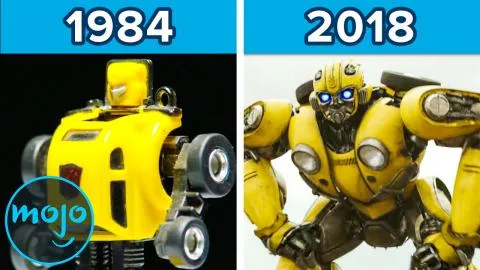Transformer Origins: Bumblebee

The Transformers franchise has gone through numerous iterations, from cartoons, to comics, to live-action movies. Across every version, certain faces have become mainstays, and the Autobot’s scout Bumblebee is no exception. The diminutive warrior first appeared in the very first wave of Transformers toys and media, a repackaged version of a Japanese toy from the “Micro Change” line. One of the smallest toys in the line, Bumblebee transformed from a pudgy little robot into a yellow VW Beetle.
When Bumblebee first appeared on the “Transformers” cartoon, he was characterized as the Autobot’s scout, using his small size and fuel efficiency to find fuel sources for his comrades. After the Autobots and Decepticons arrived on Earth and Bumblebee got his Volkswagen vehicle mode, he quickly made friends with the Autobot’s human ally, Spike. This role as the “best buddy” to the human lead would follow Bumblebee throughout his many incarnations. After all, the idea of a cool robot who can be your best pal is a pretty appealing one.
Over time, many of the classic characters were phased out in order to shine a spotlight on new characters with new toys. Bumblebee, however, continued to make appearances in the cartoon throughout its later years. Eventually, he was even rebuilt into a new form after being critically damaged. After this, he changed his name to “Goldbug” to reflect his new look.
Bumblebee was largely absent from “Transformers” media throughout the 90s and early 2000s, with shows like “Transformers: Armada” replacing him with the brash warrior Hot Shot, who was similarly young and yellow, but not really the same character.
Bee eventually returned to prominence in 2007 when Michael Bay’s first live-action “Transformers” movie hit screens, but this wasn’t your dad’s Bumblebee. The new version of the character was a battle-hardened Autobot warrior, one rendered mute after his voice modulator was damaged. Instead of speaking, this Bumblebee would use music and audio clips to communicate. He still had moments of light-hearted innocence, but the eager young cadet of the classic cartoon was gone, replaced by a powerful warrior more than ready to throw down with Decepticons. His alternate mode was even changed from the puffy Volkswagen to a rough and tumble Chevrolet Camaro.
In the live-action movies, Bumblebee was sent to Earth to find and protect Sam, the holder of a pair of antique glasses that contained the location of The AllSpark, an ancient Cybertronian artifact. Like his old-school counterpart, Bumblebee formed a close bond with his new human ally, and the two remained inseparable for the three initial films.
Subsequent versions of Bumblebee have largely stuck to one mold or the other. “Transformers: Animated” had a version of the character largely modelled after the classic cartoon, with a fully-voiced Bumblebee acting as the Autobot’s eager junior cadet. Meanwhile, the “Transformers: Prime” cartoon stuck to the mute warrior template laid down by the movies.
The Transformers franchise is all about change. After all, it’s right there in the title. But the more things change, the more they stay the same, and the continued presence of this fan favorite character proves that it isn’t always a bad thing.
